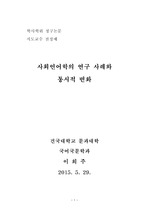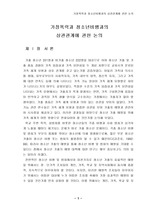

NEW
업로드 2주 이내인 자료
PARTNER
검증된 파트너 제휴사 자료
성별에 따른 ‘네’와 ‘예’의 사용과 변화 양상 (Gender differences in the use of ne and ye)
한국학술지에서 제공하는 국내 최고 수준의 학술 데이터베이스를 통해 다양한 논문과 학술지 정보를 만나보세요.
17 페이지
최초등록일 2025.03.27
최종저작일
2009.05
이 문서는 미리보기를 제공하지 않습니다.다운로드 후 해당문서의 모든 페이지를 확인할 수 있습니다.


-
서지정보
· 발행기관 : 한국현대언어학회
· 수록지 정보 : 언어연구 / 25권 / 1호 / 85 ~ 101페이지
· 저자명 : 김혜숙
초록
This paper explores whether Korean men and women use the positive responses ne and ye differently, and whether there has been a change in their usage. The responses of 570 Korean university students were used in this study. The responses of the students were observed while calling the role in class. In addition, novels by a female writer, Gong Ji-yeong, and two male writers, Kim Tak-hwan and Bak Hyeon-uk, were examined. It was found that in the past a majority of male students used ye while a majority of female students used ne. But recent data suggests that more male students have begun to use ne while female students still use ne predominantly. Overall, the distinction in usage between males and females appears to have become less noticeable.영어초록
This paper explores whether Korean men and women use the positive responses ne and ye differently, and whether there has been a change in their usage. The responses of 570 Korean university students were used in this study. The responses of the students were observed while calling the role in class. In addition, novels by a female writer, Gong Ji-yeong, and two male writers, Kim Tak-hwan and Bak Hyeon-uk, were examined. It was found that in the past a majority of male students used ye while a majority of female students used ne. But recent data suggests that more male students have begun to use ne while female students still use ne predominantly. Overall, the distinction in usage between males and females appears to have become less noticeable.참고자료
· 없음태그
-
자료후기
-
자주묻는질문의 답변을 확인해 주세요

꼭 알아주세요
-
자료의 정보 및 내용의 진실성에 대하여 해피캠퍼스는 보증하지 않으며, 해당 정보 및 게시물 저작권과 기타 법적 책임은 자료 등록자에게 있습니다.
자료 및 게시물 내용의 불법적 이용, 무단 전재∙배포는 금지되어 있습니다.
저작권침해, 명예훼손 등 분쟁 요소 발견 시 고객센터의 저작권침해 신고센터를 이용해 주시기 바랍니다. -
해피캠퍼스는 구매자와 판매자 모두가 만족하는 서비스가 되도록 노력하고 있으며, 아래의 4가지 자료환불 조건을 꼭 확인해주시기 바랍니다.
파일오류 중복자료 저작권 없음 설명과 실제 내용 불일치 파일의 다운로드가 제대로 되지 않거나 파일형식에 맞는 프로그램으로 정상 작동하지 않는 경우 다른 자료와 70% 이상 내용이 일치하는 경우 (중복임을 확인할 수 있는 근거 필요함) 인터넷의 다른 사이트, 연구기관, 학교, 서적 등의 자료를 도용한 경우 자료의 설명과 실제 자료의 내용이 일치하지 않는 경우
찾으시던 자료가 아닌가요?
지금 보는 자료와 연관되어 있어요!
문서 초안을 생성해주는 EasyAI




